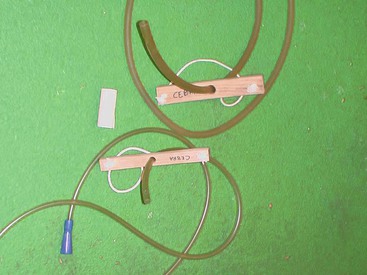Fluid Therapy
Indications
Vasculopathies and processes that depress cardiac output without specifically causing dehydration are also relatively common. Examples include septic shock caused by neonatal bacterial infection, a ruptured ulcer, bacterial enteritis, or streptococcal peritonitis, heat stress, and ingestion of cardiotoxic compounds. Affected camelids may or may not be dehydrated but may display evidence of lack of adequate perfusion. These conditions may also complicate fluid therapy protocols because leaky vessels and poor heart function may negate some of the benefits of the additional intravascular volume.
Oral Fluids and Orogastric Intubation
Allowing a thirsty camelid to drink water is the simplest way to provide oral fluids. Overhydration by this route is extremely uncommon, and polydipsia is rarely encountered. The amount that can be offered at one time is unknown. It is likely that water flows aborad relatively quickly in camelids with good gastrointestinal function, but this cannot be ensured in sick camelids. Electrolyte solutions may be used in place of water if replacement is necessary, but the high prevalence of hypernatremia in sick camelids mandates that these solutions not be used without evidence of need.
Passing an orogastric tube in an adult camelid may induce struggling and a stress response, so it is important to assess whether the patient can tolerate the procedure, to make a plan to perform the procedure quickly and competently, and to abort the procedure, if necessary. Alpacas may be manually restrained, whereas llamas may be better restrained in a llama chute. Light sedation may help, for example, with butorphanol (0.022 to 0.05 milligrams per kilogram [mg/kg], intramuscularly [IM]), which has fewer deleterious effects on airway protective responses or cardiac output compared with many other sedatives. To prevent damage to the tube because of chewing by adolescents or adults, a piece of PVC pipe or a block of wood with the edges rounded and a hole drilled through the center for the tube should be used as a speculum (Figure 32-1); crias may be tubed without a speculum. When a block speculum is used, it is introduced from the side of the mouth into the interdental space and seated on the molars. The tube is passed through the hole, over the base of the tongue, and into the esophagus. Negative pressure when sucking back on the tube, palpating the tube adjacent to the cervical trachea, or hearing fluid bubbles over the abdomen when blowing on the tube confirm correct placement. The camelid may respond by struggling, regurgitating, or going into respiratory distress. Any of these may lead to reassessment of the adequacy of the restraint or the safety of the procedure and potentially cancelling or delaying it.
Stay updated, free articles. Join our Telegram channel

Full access? Get Clinical Tree



 ” tubes are commonly used in adult alpacas (bottom).
” tubes are commonly used in adult alpacas (bottom).